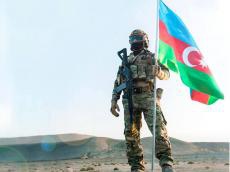|
|
TODAY.AZ / Politics
Chronicle of 44-day Second Karabakh War: November 6, 2021
06 November 2021 [10:30] - TODAY.AZ

By Vafa Ismayilova
On September 27, 2020, in response to a large-scale provocation of the Armenian armed forces along the frontline, the Azerbaijani army launched a counter-offensive operation, later called the "Iron Fist".
The 44-day war put an end to nearly 30 years of occupation, ensured the liberation of Azerbaijan's lands and the restoration of the country's territorial integrity.
Chronicle of 44-day Second Karabakh War: November 6, 2021
- Armenia violated ceasefire on the state border with Azerbaijan.
- Armenian troops were forced to retreat, suffering losses.
- Armenian armed forces shelled Tartar region's villages.
- An Armenian ammunition depot exploded near Khankandi city.
- Armenian armed forces fled, abandoning their positions in the direction of Gubadli.
- Armenian military units in Aghdara were neutralized.
- Video of the destruction of Armenian mortars in Goyarkh village was released.
- Armenian armed forces shelled Tartar region's villages, using artillery.
- Video of Fuzuli region's liberated villages was released.
- Video of shelling of the combat positions of Armenian armed forces was released.
A Moscow-brokered ceasefire deal that Baku and Yerevan signed on November 10, 2020, brought an end to six weeks of fighting between Armenia and Azerbaijan. The Azerbaijani army declared a victory against the Armenian troops. The signed agreement obliged Armenia to withdraw its troops from the Azerbaijani lands that it has occupied since the early 1990s.
The peace agreement stipulated the return of Azerbaijan's Armenian-occupied Kalbajar, Aghdam and Lachin regions and urged Armenia to withdraw its troops from the Azerbaijani lands that it has occupied since the early 1990s. Before the signing of the deal, the Azerbaijani army had liberated around 300 villages, settlements, city centres, and historic Shusha city.
URL: http://www.today.az/news/politics/211830.html
 Print version
Print version
Connect with us. Get latest news and updates.
See Also
- 21 November 2024 [15:35]
Azerbaijani minister addresses critical issues of Climate, Nature, and Indigenous Rights - 21 November 2024 [15:16]
Scottish Parliament supports COP29 peace efforts and Azerbaijan's initiatives - 21 November 2024 [14:41]
Are Pashinyan's deputies recovering? - 21 November 2024 [13:33]
Sad clowns in the arena: the old repertoire of Azerbaijan's detractors - 20 November 2024 [14:44]
They were so offended that it was even funny. What does the French Foreign Ministry expect from Azerbaijan? - 20 November 2024 [13:15]
We got as far as Noah: political provocations of Armenian myth-makers - 20 November 2024 [11:05]
Azerbaijan files lawsuit against Armenia in Hague - 19 November 2024 [15:00]
COP29 give an impetus to the salvation of the Caspian Sea - 19 November 2024 [11:12]
Azerbaijan to continue international efforts to clarify fate of hostages and missing persons - 18 November 2024 [19:00]
High-Level meeting on Human Development Day convened as part of COP29
Most Popular
 COP29 give an impetus to the salvation of the Caspian Sea
COP29 give an impetus to the salvation of the Caspian Sea
 COP29 side event discusses role of science & innovation in achieving low-emission food systems
COP29 side event discusses role of science & innovation in achieving low-emission food systems
 Azerbaijan's U-17 & U-19 teams to play final matches in qualifying round
Azerbaijan's U-17 & U-19 teams to play final matches in qualifying round
 They were so offended that it was even funny. What does the French Foreign Ministry expect from Azerbaijan?
They were so offended that it was even funny. What does the French Foreign Ministry expect from Azerbaijan?
 High-Level meeting on Human Development Day convened as part of COP29
High-Level meeting on Human Development Day convened as part of COP29
 London and New Delhi resume free trade talks
London and New Delhi resume free trade talks
 European Union require companies from China to place production in Europe
European Union require companies from China to place production in Europe
